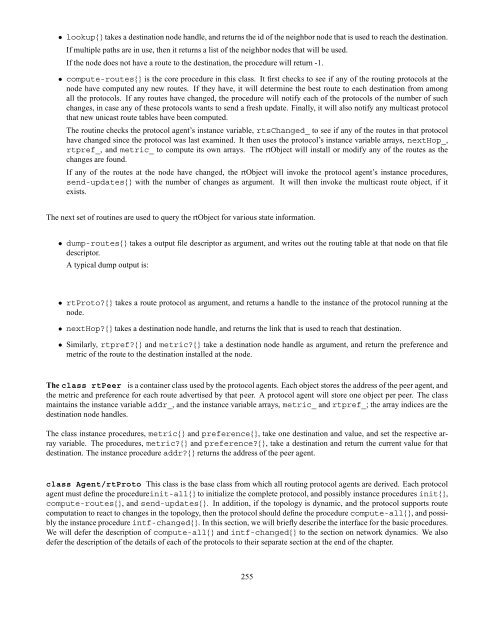The ns Manual (formerly ns Notes and Documentation)1 - NM Lab at ...
The ns Manual (formerly ns Notes and Documentation)1 - NM Lab at ...
The ns Manual (formerly ns Notes and Documentation)1 - NM Lab at ...
- No tags were found...
You also want an ePaper? Increase the reach of your titles
YUMPU automatically turns print PDFs into web optimized ePapers that Google loves.
• lookup{} takes a destin<strong>at</strong>ion node h<strong>and</strong>le, <strong>and</strong> retur<strong>ns</strong> the id of the neighbor node th<strong>at</strong> is used to reach the destin<strong>at</strong>ion.If multiple p<strong>at</strong>hs are in use, then it retur<strong>ns</strong> a list of the neighbor nodes th<strong>at</strong> will be used.If the node does not have a route to the destin<strong>at</strong>ion, the procedure will return -1.• compute-routes{} is the core procedure in this class. It first checks to see if any of the routing protocols <strong>at</strong> thenode have computed any new routes. If they have, it will determine the best route to each destin<strong>at</strong>ion from amongall the protocols. If any routes have changed, the procedure will notify each of the protocols of the number of suchchanges, in case any of these protocols wants to send a fresh upd<strong>at</strong>e. Finally, it will also notify any multicast protocolth<strong>at</strong> new unicast route tables have been computed.<strong>The</strong> routine checks the protocol agent’s i<strong>ns</strong>tance variable, rtsChanged_ to see if any of the routes in th<strong>at</strong> protocolhave changed since the protocol was last examined. It then uses the protocol’s i<strong>ns</strong>tance variable arrays, nextHop_,rtpref_, <strong>and</strong> metric_ to compute its own arrays. <strong>The</strong> rtObject will i<strong>ns</strong>tall or modify any of the routes as thechanges are found.If any of the routes <strong>at</strong> the node have changed, the rtObject will invoke the protocol agent’s i<strong>ns</strong>tance procedures,send-upd<strong>at</strong>es{} with the number of changes as argument. It will then invoke the multicast route object, if itexists.<strong>The</strong> next set of routines are used to query the rtObject for various st<strong>at</strong>e inform<strong>at</strong>ion.• dump-routes{} takes a output file descriptor as argument, <strong>and</strong> writes out the routing table <strong>at</strong> th<strong>at</strong> node on th<strong>at</strong> filedescriptor.A typical dump output is:• rtProto?{} takes a route protocol as argument, <strong>and</strong> retur<strong>ns</strong> a h<strong>and</strong>le to the i<strong>ns</strong>tance of the protocol running <strong>at</strong> thenode.• nextHop?{} takes a destin<strong>at</strong>ion node h<strong>and</strong>le, <strong>and</strong> retur<strong>ns</strong> the link th<strong>at</strong> is used to reach th<strong>at</strong> destin<strong>at</strong>ion.• Similarly, rtpref?{} <strong>and</strong> metric?{} take a destin<strong>at</strong>ion node h<strong>and</strong>le as argument, <strong>and</strong> return the preference <strong>and</strong>metric of the route to the destin<strong>at</strong>ion i<strong>ns</strong>talled <strong>at</strong> the node.<strong>The</strong> class rtPeer is a container class used by the protocol agents. Each object stores the address of the peer agent, <strong>and</strong>the metric <strong>and</strong> preference for each route advertised by th<strong>at</strong> peer. A protocol agent will store one object per peer. <strong>The</strong> classmaintai<strong>ns</strong> the i<strong>ns</strong>tance variable addr_, <strong>and</strong> the i<strong>ns</strong>tance variable arrays, metric_ <strong>and</strong> rtpref_; the array indices are thedestin<strong>at</strong>ion node h<strong>and</strong>les.<strong>The</strong> class i<strong>ns</strong>tance procedures, metric{} <strong>and</strong> preference{}, take one destin<strong>at</strong>ion <strong>and</strong> value, <strong>and</strong> set the respective arrayvariable. <strong>The</strong> procedures, metric?{} <strong>and</strong> preference?{}, take a destin<strong>at</strong>ion <strong>and</strong> return the current value for th<strong>at</strong>destin<strong>at</strong>ion. <strong>The</strong> i<strong>ns</strong>tance procedure addr?{} retur<strong>ns</strong> the address of the peer agent.class Agent/rtProto This class is the base class from which all routing protocol agents are derived. Each protocolagent must define the procedureinit-all{} to initialize the complete protocol, <strong>and</strong> possibly i<strong>ns</strong>tance procedures init{},compute-routes{}, <strong>and</strong> send-upd<strong>at</strong>es{}. In addition, if the topology is dynamic, <strong>and</strong> the protocol supports routecomput<strong>at</strong>ion to react to changes in the topology, then the protocol should define the procedure compute-all{}, <strong>and</strong> possiblythe i<strong>ns</strong>tance procedure intf-changed{}. In this section, we will briefly describe the interface for the basic procedures.We will defer the description of compute-all{} <strong>and</strong> intf-changed{} to the section on network dynamics. We alsodefer the description of the details of each of the protocols to their separ<strong>at</strong>e section <strong>at</strong> the end of the chapter.255
















